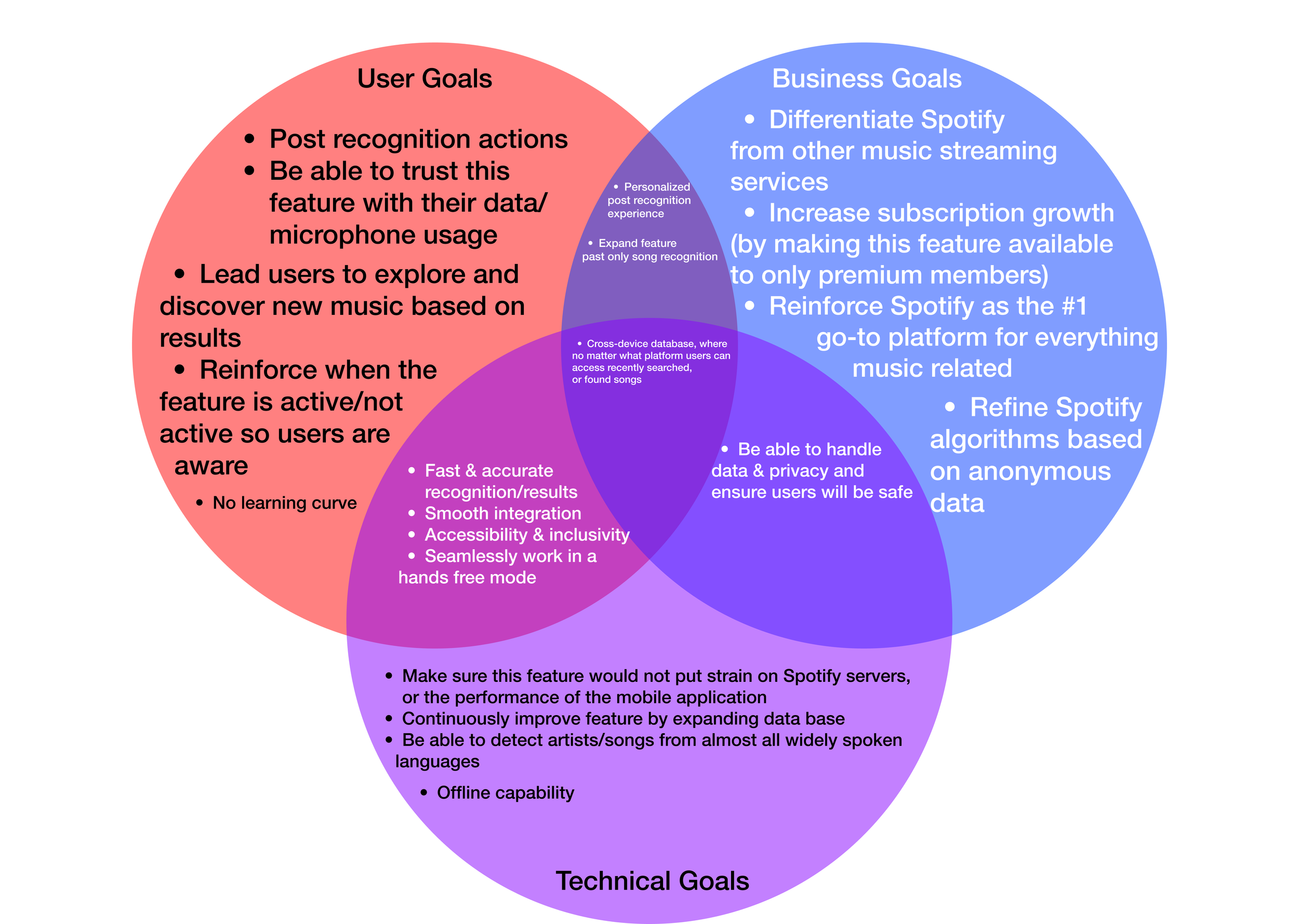
TLDR:
Problem: Current Spotify premium members are unable to identify songs and artists using their microphone within the application, forcing them to turn to outside applications like Shazam, or Siri.
Solution: A hands-free music recognition feature within the Spotify mobile app, giving Spotify premium users the ability to identify songs and artists through audio input alone — without ever leaving the app.
Process & Reflection: Through user interviews and usability testing, I was able to validate this features existence within Spotify’s current ecosystem. Refining UI placement, interactions and user flows, then solidifying post-recognition actions.
Full-Length Case Study
Background
Spotify is the leading music streaming, podcast listening, and audiobook library. Yet users are still not able to search their database using their microphone, audio samples, and recordings.
Research Goal
Why do Spotify members have to use another application or service, to find the name of a song, or find the artist behind it?
Research Objectives & Methodologies
Users should be able to have a seamless listening and exploring experience within Spotify.
Spotify should stay consistently easy to use, even when users only have one, or no hands available.
Some users struggle to explore and discover new sounds because they are unable to capture and identify songs using they hear around them, leading to missed listening opportunities.
What did we learn?
User interviews gave us the following insights
5 Participants were interviewed - 4 Current Spotify premium members, 1 Non-Spotify user.
None of the participants currently use a dedicated music recognition app; instead, they typically ask Siri or rely on friends to identify songs.
While 2 out of 5 participants use their own music in the car, the remaining 3 primarily listen to the radio, which also serves as a key source for discovering new music.
Additionally, 3 participants said they enjoy finding new music but don’t know how to actively seek it out—often stumbling upon songs via the radio or background music in shows or movies.
All participants shared that identifying songs or discovering new music often feels tedious, and unanimously assumed that streaming platforms like Spotify would already have a built-in feature to identify songs and display the artist and track name.

How might we develop a system that enables Spotify users to find new music, while keeping them on the application, and hands-free?
Project Goals & Feature Set
Business Goals
Differentiate Spotify from other music streaming
servicesIncrease subscription growth (Feature only available to Spotify Premium members)
Reinforce Spotify as the leader of all audio related mobile applications.
User Goals
Have useful post recognition actions
Be able to trust this feature with their data/microphone usage
Lead users to explore and discover new music based on
resultsReinforce when the feature is active/not
active so users are aware
Technical Goals
Make sure this feature would not put strain on Spotify servers, or the performance of the mobile application
Continuously improve feature by expanding data base
Be able to detect artists/songs from almost all widely spoken languages
User Testing - Participant reaction to the feature, and initial designs.
The previous group of participants underwent a second round of testing.
Several participants noted that the feature was integrated into the existing “Search” tab, which two of them appreciated—saying it helped avoid confusion, misclicks, or dissatisfaction that might come from altering the bottom navigation bar. However, one participant felt that if the feature were to be fully detailed, it deserved its own dedicated tab despite the potential disruption to Spotify’s current flow.
All participants agreed that on the “song result” screen, the key action icons (like, add to playlist, download, search again) were too tightly packed and needed more space or to be repositioned for better usability.
Two participants responded positively to the widget screens, saying they would add them to their own home screens for quick access. However, multiple participants were confused by the use of the waveform icon replacing the camera icon in the search bar, revealing that many Spotify users are unaware of the existing “Spotify codes” feature. Several participants also expressed surprise that this music recognition feature doesn’t already exist in the app.
First Round High-Fidelity Wireframes
Usability testing - How can we positively iterate upon these wireframes?
5 Participants were interviewed and had access to the wireframes, producing the following results.
All 5 participants completed every single task, in under three minutes. No errors, or blockers found.
Clearly the feature works as intended, and blends seamlessly into the pre-existing Spotify landscape, majority of time spent during the tasks was just the participants looking around, seeing what had, or had not changed, or just exploring the Spotify mobile layout if they don’t use the application themselves.
Interview takeaways
Change layout of the song result page, focus on the essential buttons for next steps, make sure they are all distinct, have enough space between each other, and are in a section of the screen that makes sense.
Work on titles / descriptions for function, make it easier to remember, more catching, and a little bit more creative.
Somehow incorporate or reinforce that users data is safe and secure, the microphone will only be active when the feature is active, etc.
Work on widget versions of the feature, make it more easily accessible, potentially add a siri like function(?)
Final High-Fidelity Wireframes
Reflection:
Reflecting back, what halted my progress most was being a perfectionist—trying to perfectly emulate the base app’s design system and style. I got hung up on implementing user testing feedback and properly applying it to my designs.
The interview process was still new to me, so it was tough to interpret results and translate them into efficient design, style, and function choices.
I’ve gained knew knowledge of how to improve an existing app’s function significantly while working within its limitations. I loved working within Spotify’s design system and hope to have similar opportunities again.











